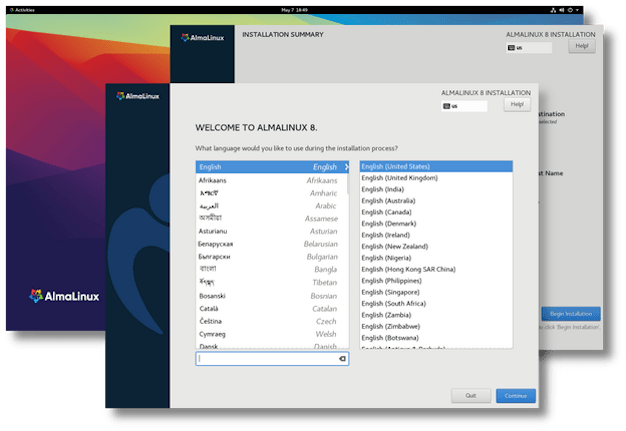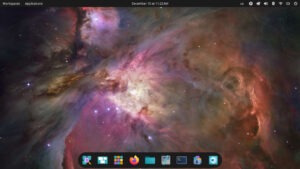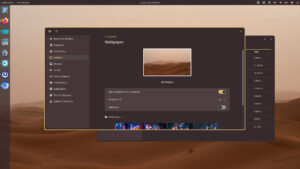As AlmaLinux and Rocky Linux vie for dominance in the free RHEL replacement space that was abandoned by CentOS Linux, Alma appears to be making deeper inroads on several fronts.

The few who were expecting cries of anguish to start when CentOS 8 became unsupported at the strike of midnight on New Year’s Eve, were likely surprised when January came and went with nary a whisper about the loss of a Linux distribution that months earlier had powered millions of servers running mission critical workloads in data centers around the world.
A year earlier Red Hat, which had sponsored the 18-year-old project for the better part of a decade and owned the CentOS trademark, announced it was closing the project down, while keeping the CentOS name for a different, if similar, distro.
This was a big deal. As a feature-for-feature downstream clone of Red Hat Enterprise Linux, many enterprises depended on the distro as a way of running RHEL without having to pay a Red Hat tax, which is probably why Red Hat wanted to see it go.
While several existing Linux distros immediately raised their hands to offer themselves as potential CentOS replacements (most notably Oracle Linux, already a near clone of RHEL), two impressive new distro projects surfaced to fill the void and now dominate the market that CentOS left behind.
Both of these Linux distributions were announced within hours of each other, soon after Red Hat made its announcement. Rocky Linux was announced first, and got the lion’s share of the initial attention from the press because its founder, Gregory Kurtzer, founder and CEO of CIQ, has a complicated connection with CentOS’s genesis, with many seeing him as the logical choice to raise a new CentOS out of the ashes.
A short time later, the distro that eventually became known as AlmaLinux after a lengthy naming process, was announced by Igor Seletskiy, CEO of CloudLinux, a hardened CentOS-based commercial distribution designed primarily for web hosting companies. With CentOS on the way out, Seletskiy evidently figured he’d have to find another way of bringing RHEL parity to CloudLinux.
A little over a year later, both distros are up and running, both are seeing large numbers of installs by large enterprises and smaller users alike, both have found a degree of funding, and both have seen several successful releases. They’re also both solid distros.
However, maintaining a distro that can meet the security and regulatory requirements of Fortune 500 companies using the software to run mission critical production workloads is expensive, so it’s probable that only one of these distros will survive for the long term.
It’s likely that distro will be AlmaLinux.
Enterprise Support
“We founded the AlmaLinux OS Foundation for the specific goal of creating a CentOS successor that allowed those who had a stake in the future of the operating system to also have a voice,” the AlmaLinux OS Foundation’s chairperson, benny Vasquez (not a typo, she spells her first name all lower case), said in a press release a couple of weeks back. “Our success simply is not possible without support from our members, and it’s exciting to have such a strong response across key industries using Linux.”
The press release announced four new dues paying members, about three months after the foundation announced that immutable database startup, Codenotary, had signed-on to join AlmaLinux as a $100,000 a year top tier Platinum supporter.
“Sending out a big welcome to Sine Nomine, AMD, BlackHOST, and Knownhost,” Vasquez said. “If your organization cares about the future of the best downstream RHEL-clone out there, come talk to us! Your voice matters here, and we are excited to prove that to the world. This is how open source grows and flourishes.”
What is most interesting about this new round of members is the addition of Sine Nomine Associates. Joining at the $20,000 per year Gold Level, the company introduced the concept of virtual server farms using Linux on the S/390 IBM mainframe. This is interesting, because in late February AlmaLinux began supporting IBM’s Power architecture, and Sine Nomine’s involvement could put it on track for supporting IBM’s System z, the only remaining architecture supported by RHEL that Alma doesn’t support.
This would help put it further ahead of the competition, since so far Rocky Linux only supports x86-64 and Arm Aarch64, although the project is reportedly working on adding IBM Power support.
“Linux is a foundational technology for mainframes, making the reliability, scalability, and security of mainframe architecture more broadly accessible,” Kurt Acker, the principal IT architect at Sine Nomine Associates said in the press release. “We are pleased to be joining the AlmaLinux OS Foundation and helping to create strong alternatives for CentOS and other Linux users on mainframes moving forward.”
The most recognizable name on the list of new members, chipmaker AMD, said it’s joining Alma’s foundation to sustain support for AMD products.
“At AMD, we build products that help solve our customers’ biggest business challenges,” Raghu Nambiar, a corporate VP at AMD’s data center ecosystems and solutions said. “We are proud to contribute to community-driven open-source projects like AlmaLinux, that foster an open and accessible Linux ecosystem.”
AMD joins at the Silver level, which only requires a $2,500 annual commitment, as do KnownHost and BlackHOST.
The money figures attached to the dues don’t necessarily mean cash-out-of-pocket, as there are alternate methods that AlmaLinux OS Foundation members can use to honor their financial obligations. In lieu of cash payment, Platinum members can supply three full time employees working on AlmaLinux; Gold members can supply one full time employee, annual service credits, or a hardware donation valued at $20,000 or more; and Silver member can make a contribution of services or hardware. All alternate payment methods require prior approval by the foundation’s membership committee, with Silver members also requiring approval by the board of directors.
It’s not surprising that the two other new members are hosting companies, given CloudLinux’s popularity with hosting providers who use it as the underlying OS on which to run virtual machines. Since CentOS has traditionally been the default distro that hosting companies offer their customers, it only makes sense for them to make AlmaLinux the new default instead of Rocky or something else, since it shares the same code base as their underlying operating system.
KnownHost’s involvement is particularly interesting to us at FOSS Force, because it’s been the company hosting our site for nearly ten years, and a couple of months ago we became affiliate partners (which means that if you click on a KnownHost link on our site and end-up signing up for a hosting account, we’ll get a commission). This makes KnownHost’s relationship with AlmaLinux a major reason behind our decision to move FOSS Force to AlmaLinux in the near future.
“Web hosting runs on Linux and AlmaLinux provides a clean CentOS migration path and strong community engagement,” KnownHost’s COO, Daniel Pearson said. “By joining the AlmaLinux OS Foundation, we will continue to provide the best web hosting technology solutions for our customers.”
The other hosting company that’s now onboard as an AlmaLinux member is BlackHOST, which specializes in providing unmetered networking solutions ranging from 1Gbps up to 100Gbps, with points of presence around the world.
“We have made AlmaLinux our default OS choice when our clients are ordering VPSes and dedicated servers,” Thomas Nuchatel, CTO at BlackHOST said. “Linux is a key technology in web hosting and a range of other cloud infrastructure services, and AlmaLinux is the type of community-based distribution that provides value to our customers.”
AlmaLinux’s Technology
Not only does AlmaLinux seem to be in front in terms of financing, it’s also ahead of the game in the technology department, where its developers have demonstrated the efficacy of their development technology twice already.
This started with the distro being the first out-of-the-gate with it’s first release, AlmaLinux 8.3, last March, nearly three months ahead of Rocky Linux’s first release, even though they both began development at about the same time. In November, less than 48 hours after RHEL 8.5 was released, AlmaLinux devs released their own 8.5 version based on it, several days ahead of Rocky.
The project has also developed and released open source software that potentially benefits anyone using RHEL or any its clones. ELevate is software that makes it much easier to migrate from one major point version of any RHEL-based distro, to another major point version of any RHEL-based distro. For example, it can be used to migrate from CentOS 7 to AlmaLinux 8, Oracle Linux 8, Rocky Linux 8, or even RHEL 8.
Christine Hall has been a journalist since 1971. In 2001, she began writing a weekly consumer computer column and started covering Linux and FOSS in 2002 after making the switch to GNU/Linux. Follow her on Twitter: @BrideOfLinux











Everyone seems to forget that the primary developers of Alma are paid by CloudLinux to do the work. Alma may be ahead of Rocky, but there’s a difference between Alma and Rocky: Rocky’s development and teams are all volunteers. One could argue things would be different with Rocky if the devs and other teams were paid to do the work, but there could be FUD created as a result and yet another set of pointless battles.
I’m glad everyone seems to be ignoring EuroLinux, yet another EL clone too. Then again, EuroLinux seems pretty similar to Oracle Linux. So maybe it’s a good thing.
EuroLinux was one of the distros I meant when I said that several raised their hands. I had a Zoom with them about six months back. Nice people, but I don’t think they’re really ready to compete at the level that a major server distribution needs to compete on a global scale, although they are popular enough in Poland where they are located.
As you hint, the company also seems to have a few transparency issues that need to be ironed out, and I got the impression that might be the biggest obstacle for them to overcome.
Don’t put all eggs in one basket. Two or three forks are necessary.
The question is: Why would someone fork RHEL?.
-Rockylinux is related to Warewulf and Singularity. It was probably intended for HPC -not exclusive-.
-Almalinux has some connection with cPanel. I expect hosting companies joining.
-Eurolinux: ??
Sadly, the authors do not explain “I use my distro for VPS/KVM/HPC and the money comes from there”.
There is a lot of money behind hosting and HPC. Two distros have a bright future.
L. M. you are bit naive if you think that core Rocky team is working for free…
Hi, core Rocky team guy here. Can confirm that most of us (not all) are, in fact, “working for free”. We did get some free Rocky swag passed out several months ago though, so that was nice.
There are a couple core members who are paid to work on Rocky, and it’s nice because they can contribute a lot. Overall it’s been a fun project, and a fun group so far!
Rocky Team Guy: Thanks for the heads up! I hope you guys can start getting a paycheck soon!
Hi!
Note: I’m EuroLinux Developer. I want to address some of the topics introduced in this discussion about the distro I help create and FOSS general.
L.M. – I always thought that fact that people have a choice is the most fundamental principle of open source and free software. I’m glad that people can ignore us – in the meantime, we can do our work, day by day, step by step, migrated system by migrated system.
Everyone in the discussion noticed an important fact – developers must get their paycheck. It’s always sad to read that having a sustainable business model for free/open-source software is bad; as You said: “One could argue things would be different with Rocky if the devs and other teams were paid to do the work, but there could be FUD created as a result and yet another set of pointless battles.”
In reality, Your whole point was dismissed by Rocky Linux insider: ‘Can confirm that most of us **(not all)** are, in fact, “working for free”. ‘.
With that mindset, we can listen to another podcast/post/opinion about how it is possible that another ‘log4shell/heartbleed/centos drama’ happens. Then everyone will talk about poor financing. Some people create or switch to a fork (ex. libressl/boringssl) in the best-case scenario, most will whine about it, and after another shocking discovery (that free software needs funding), nothing changes.
As I’m one of the people that likes distrohopping in an enterprise Linux environment, everyone should look broader. I want to stress that RHEL and clones have an extremely long lifecycle, so maybe using something that wasn’t created a year ago (Alma,Rocky) and wasn’t available for the public for a long time (EuroLinux) might influence the risk matrix. In that case, Oracle Linux might be the best choice.
Christine wrote: “As you hint, the company also seems to have a few transparency issues that need to be ironed out, and I got the impression that might be the biggest obstacle for them to overcome.” Could you hint/elaborate on what you meant by that? I’m in power to change and clarify a lot.
Mario, you noticed that: “Sadly, the authors do not explain “I use my distro for VPS/KVM/HPC and the money comes from there”. When it comes to EuroLinux I can give you three sources of income (system, value-added and ecosystem)
When it comes to a system:
– Companies that use gold key (unlimited number of machines). Gold Key is dirt cheap compared to OL and RH. Note that includes **producer** support, and many companies and organizations are **required by law** to use only software with producer support (that RL and AL won’t provide it by design). They can also use a single system in prod/staging/qa/test/local environments, which simplifies a lot.
– Companies that rebuild RHEL for their purposes. We set up “normal” fork from RHEL or our sources, rebrand it (if required), and help maintain changes (like additional security modules/microscopic images/custom hardware and other exotic features). In every release on our blog/docs we are writing about it. Note that this is quite expensive.
– Users that want to have a supported system in countable amount.
When it comes to value-added:
training – it might sound trivial, but when a client says that they need Linux administration/PostgreSQL/Ceph/JBoss training, we have them covered
continuous care – it is similar to Technical Account Management (TAM), but we call it Technical Unit (TU)
The last source of income is that we have a stack that is a little bit more than a system. TBH, most of our revenue comes from different products than EuroLinux like EuroAP (JBoss replacement), EuroSSO (Single Sign-on) and EuroDB (Postgresql with some additional modules). As you can imagine single migration from rather an expensive Oracle to PostgreSQL might be more profitable than even 1000 EuroLinux installations. When you buy any of our products, you can use any Enterprise Linux (including RHEL, Oracle, Alma, Rocky) or EuroLinux with support for free.
I will monitor this thread to directly address any concerns and answer any questions.
Had a go at it this morning… nope!! Not for me. First off, the ISO is 9.9 GB in size. Why? Then it took over 45 minutes to install. BUT… the final straw was the DE – Gnome. Nope.
An open source contributor here and engineer at a very large enterprise here.
“Working for free” is a misnomer in Open Source. Yes, there are some, but there are also a number of people who are paid to contribute and be part of projects like Rocky by their own companies. As the Rocky founder has said, the way to create a stable open source project is to have a diverse group of companies supporting it, and they do.
This article already hasn’t aged well! Check out the recently announced CIQ and Google partnership to collaboratively support Rocky Linux which was announced shortly after this article was written. No wonder CentOS and RH seemed to have chosen Alma, Rocky is taking over!
Also, Alma has taken shortcuts to release sooner. For example, using CloudLinux infrastructure, secure shims, and the build infrastructure that is owned entirely and developed by CloudLinux. They even state that in their transparency statement that is almost a year past late on their goals of open sourcing their build code. Alma is CloudLinux.
Rocky is way ahead of Alma with regard to community commitment and diverse involvement from companies and sponsors. It is obvious to anyone paying attention.
A fairly written article would have identified these issues with Alma as well as the higher rate of growth, enterprise adoption, and community support of Rocky Linux. This is an opinion piece, and one that seems like it was paid for.
Why argue about all these silly distrobutions when Navy Linux exists? https://navylinux.org